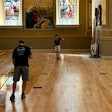
It all started December of 2015 with a devastating fire in a beautiful country mansion in New Hampshire where, luckily, no lives were lost. The flames engulfed the entire home, and over 50 firefighters had to be brought in to battle the blaze, as this rural area had no fire hydrants. This is where our floor story begins.
Currently, this home is being rebuilt, and there are several thousand square feet of new 3¼-inch red oak flooring. The installation was completed and the second story was coated, but on the first floor they noticed a severe technical problem:
Absolutely perfect wave alignment … but not where they edged! The first clue…
I was called by Vernon Wilson, owner of Wilson Installations in Bedford, N.H., and he said he had "wave" from his Hummel, and after two sandings it not only would not go away; it was getting worse.
Vernon had been told all the usual things:
"Hummels are known for that."
"It's your upper roller assembly."
"Your bearings are shot."
You name it, the usual bad rap. I wanted to help straighten this out and knew for a fact it was not the machine … exactly. One thing many flooring contractors are not familiar with—but many mechanics are—is "resonance (resonant) frequency," and this is what I believed we had here. Let me explain, and then it will all come together (and maybe even save someone a ton of dough rebuilding a perfectly good floor sander).
Hummels, like any other floor sander, or any machine, musical instrument or mechanical structure, operate or "vibrate" at a certain wavelength, or frequency, measured in Hertz (Hz), according to Eric Ungar, ScD, P.E., and chief engineering specialist at Acentech Inc. in Cambridge, Mass. And, that frequency is low, say 1–10 Hz, likely around 5 Hz. Thinking what I had here was resonance frequency, I found an online publication written by Mr. Ungar; Thomas Murray, Ph.D., P.E., of Virginia Polytechnic Institute; and David Allen, Ph.D. of the Institution of Research in Construction. They had written a 71-page document entitled, "Floor Vibrations Due to Human Activity". The first chapter dealt with the construction of subfloor structures, particularly those including steel I-beams, laminated I-beams, steel (lally) columns and concrete slabs. The section focused on two things in particular: vibration from human activities (walking, dancing) and the use of machinery—like a floor sander. And there it all was spelled out:
Floors ALSO have a distinct and measurable vibration frequency based on their construction and four types of dynamic "loads."
To make this simple, our problem involves a "harmonic" or "sinusoidal" load situation.

Notice the wave harmonic becomes perfectly uniform! Getting to the point: Our problem here was that the Hummel and the floor had the same resonant frequency.
We have all seen some form of waves on TV or a heart monitor or something, and they spike up and down; they are usually not harmonic. Like the word indicates, it is like singing in harmony, like sitting stuck in traffic on a bridge and you feel your car bouncing rhythmically. The Hummel and the subfloor were in total harmonic sync. They were singing together so perfectly you could feel it under your feet while sanding.
I asked Vernon Wilson a lot of questions, but here is what we found most important: It was NOT the Hummel! He sanded 3,000 square feet on the second floor beautifully. But when he started to re-sand the first floor, the wave got worse. He spoke with both me and Frank Rosselli, a reputable veteran floor machine mechanic, and Frank agreed: resonance frequency. Technicians have to know these things, because so many contractors spend a lot of money to tune up their equipment only to blame the mechanic when something like this happens. Any sander of similar design would have this problem.
I went to study the job site and found the first floor was supported by a massive steel I-beam and lam beams with steel lally columns set in concrete:

There was nothing that would dampen the resonance.
Eric Ungar's paper gave me the simplest answer. The report stated:
For floor serviceability, stiffness and resonance are dominant considerations in the design of steel floor structures and footbridges. The first known stiffness criterion appeared nearly 170 years ago. Tregold (1828) wrote that girders over long spans should be "made deep to avoid the inconvenience of not being able to move on the floor without shaking everything in the room." Traditionally soldiers "break step" when marching across bridges to avoid large, potentially dangerous, resonant vibration.
You might have seen this video of the infamous Tacoma Narrows bridge collapse—also a case of resonant frequency:
When using a planer or jointer, any crafty woodworker can tell you the differences and importance of density (frequency) of different species of wood. Running poplar, cherry, butternut or pine through a planer is one thing. Then try the same machine with hickory, rock maple or an exotic! OUCH! It looks like this:

The choice of wood species is critical in the construction of musical instruments, where the wood's resonance is imperative to the instruments performance; guitars, violins, drums and pianos use a lot of metals, as well.
Back to our floor … If my hypothesis was right, then we needed to find a machine that could sand the floor without resulting in a resonant frequency. I had them resand an area with the Hummel cutting at a 15-20 degree angle to see if that would help. Not only did the waves return, they were NOT at a 15-20 degree angle! They remained totally the same. More evidence. No more drums or belts on this; the idea was to move to a rotary sander since the edger had been successful. Vernon tried using a hard plate on a buffer with various grit paper discs, but it got WORSE, spreading the waves wider. He cut the finish and stain off with a UFO using very coarse paper and screens, and it did remove the finish, but the photo shows the results:

We had an idea for the final solution to this 2,600-square-foot nightmare. I called Michael Overy, my Bona rep and longtime friend and ex-colleague at Wood Pro Inc. He sent over the new Bona PowerDrive.
Vernon Wilson was running the PD on the job, and it is by my house, so I decided to see how things were going. The waves were slowly fading, but I noticed he had the wrong paper. I set him up with 60-grit green ceramic 6-inch discs—I know he was thinking, "Man if 36 on a UFO can't do this, how will 60?!" But, ceramic paper is a whole other ballgame. Vernon set up the discs, and we put two small wooden blocks on top of the PD motor for ventilation, then placed a 40-pound bag of grout mix on top of the motor for added cutting weight. (The new Bona machines will have weights, so we thought this could be effective.) Look at the photos—the finish, stain and waves began to disappear immediately:
We cleaned the dust containment system, reset the machines and jumped on the 60-grit for about an hour until the lighting became poor. Vernon began the next day and gave me the results of his final "recipe."
The PD had cut the edging down to almost nothing. The next cut with the PD was green ceramic 80-grit: beautiful! Vern jumped back to 100-grit and 120-grit on the UFO since the wave was gone, and he wanted to avoid "hoops" and "hooks" from showing up in the stain, which can happen with rotary machines. He had no room for error.
I suggested he water-pop the floor before staining, so he did a test: He hand-sanded a small area with a folded 120-grit screen and then water-popped that area and the area next to it. He waited for it to dry, and as nice as it looked, the hand-sanded area stained even better than the area next to it. Not wanting any more trouble, Vern and his guys hand-sanded all 2,600 square feet with folded 220 screens, water-popped and stained. They coated over that with an oil sealer and then an oil-modified 550-VOC polyurethane. I only have a few photos because they will do a final when all other work is done, but you can see the massive difference. Guess what, Hummel dudes? NOT THE MACHINE!

The people working on this massive restoration are thrilled that the curse of the wave is over and everyone gets their lives back, particularly the family that lost so much in this tragic fire. I have to thank William Wild from the University of Rhode Island Physics Department for his explanations of the science and physics involved; he really helped us take a more technical and calculable approach for a solid resolution of the matter. Out with the "Armchair Floor Guy" stuff! We needed real science. To my hardwood flooring brothers and sisters, two words for your professional resume: resonance frequency!
MIC DROP! BOOM!

































